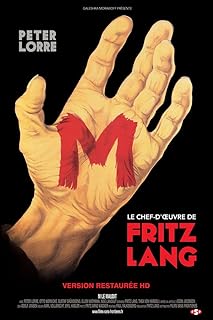電影訊息
M--M
編劇: Thea von Harbou 佛瑞茲朗
演員: 彼得羅瑞 Ellen Widmann Inge Landgut Otto Wernicke
M就是凶手/可诅咒的人/凶手就在我们中间
![]() 8.3 / 168,533人
117分鐘 | 110分鐘 (2004 Criterion DVD edition) | France:118分鐘 | Germany:105分鐘 (2000 restored version)
8.3 / 168,533人
117分鐘 | 110分鐘 (2004 Criterion DVD edition) | France:118分鐘 | Germany:105分鐘 (2000 restored version)
編劇: Thea von Harbou 佛瑞茲朗
演員: 彼得羅瑞 Ellen Widmann Inge Landgut Otto Wernicke
電影評論更多影評

2011-07-07 15:50:42
Scene analysis of M (1931)
Scene analysis of M (1931)
(The scene I will analyze in this essay is the underworld trial of Hans 貝克t (the serial murder), which runs from 1:34:26 to 1:48:59.)
In the penultimate scene of M, Fritz Lang creates suspense and tension in the confrontation between 貝克t the individual and the crowd as a collective through the use of off-scene voice, visual contrast in mise-en-scène as well as different framing and cutting. With these film techniques Lang not only depicts the isolation of 貝克t as a psychiatrist, but also the potential brutality and hysteria of the mass.
The first vital component to this scene is the off-screen sound. As Lang's first "talkie" film, M is renowned for its sophisticated use of sound. In this scene of the underworld trial, the off-screen sound/voice is basically used to bond the shots cohesively and strengthen the sense of continuity in the narrative. For example, in the first few shots, when the two escorts come downstairs and get into the corridor to bring 貝克t out, the camera keeps still at the dark arch until the screaming of 貝克t is heard approaching. It is for a while after the voice appears that the struggling 貝克t under escort shows up from the depths of darkness in the arch. Then the camera tilts up to track the trio struggling to the door upstairs. In the second shot, what appears first is a closed door, accompanied by the din continued from the end of the previous shot, particularly 貝克t's yelling "Let me go!" Temporal and spatial continuity is thus established between these two shots, as we know, before seeing the door open and the four men enter, this is the other side of the door and it's most likely that they will enter.
In some of the dialogue scenes, moreover, off-screen voice goes with the reaction of the object within one shot. Pushed downstairs, 貝克t turns and sees the 「court」; then follows the POV shot of 貝克t, panning from left to right to present the "jury" and the "panel"; then 貝克t turns back to yell "Let me out!" at the escorts. The next shot to it shows the crowd again, accompanied by the hysterical yelling. This is obviously not the POV of 貝克t, who is supposed to be facing the door. In this sense, the objective shot captures the silent reaction of the crowd to 貝克t's frenzy, with repressed agitation and a tinge of cruelty. The contrast between the physical quietude and auditory tumult sets up the tone that 貝克t is at the mercy of the mass. The distance they keep from 貝克t, enhanced by the objectivity suggested by the shot, implies that they see him as a monster that they will never and refuse to understand.
Furthermore, in this scene, there are three noticeable parallel shots with (or without) off-screen voice in order to create suspense. These three shots are composed in similar fashion: one arm, in company with the off-screen voice, enters the frame to pat 貝克t on the shoulder. In the first shot said, when 貝克t is claiming that his arrest must be a mistake, the arm of the vendor enters from the left of the frame, with the voice of the vendor: "No, this is no mistake", and the camera tracks leftwards to include the vendor and 貝克t in the frame. The second shot runs similarly: first enters the finger of the "lawyer", poking from above at 貝克t, who quivers at the foot of the fence and exclaims that he does not need the defense counsel that only ends up prosecuting him, then the camera tilts up to show the "lawyer". In the final shot of the scene, an anonymous arm reaches to 貝克t from the right of the screen, a voice noting him: "You are now under the name of the law". As with the third arm, we never see who the owner is. The unexpectedness in these shots, on the one hand, intensifies the advent of an accusation/defender/real trial, and on the other hand, effectuates in producing a sense of control over the fate of 貝克t.
In visual terms, the scene comprises an array of contrasts in shadow and light, flatness and depth, collective and individual. The contrast is first conveyed in mise-en-scène. With the vestiges of Expressionism, the basement where the "trial" is held is heavily piped, not only a metaphor for the distorted psyche, but also a salient symbol of early industrialization and a time of insecurity, when individuals tend to rely on collective strength. The contrast of strength between the crowd and 貝克t (and later, 貝克t with his defender) becomes a graphic motif throughout the scene. Back to the beginning shots in which 貝克t is tossed down the stairs: 貝克t 's POV shot examines the "court room," which is cramped with ex-convicts, gangsters and revengeful civilians. In this long, panning shot, the faces of the mass are small and vague, mostly under the shadow cast down from the arched ceiling. In the reverse medium long shot, 貝克t appears alone at the foot of the stairs, with two escorts overlooking him. This shot of 貝克t, as many more later, is at a higher level of brightness and volume, compared with the flatterer images of the mass. The stark visual contrast can be interpreted as the isolation of 貝克t. But further, in a lot of shots of the mass, the shadow of the ceilings overhead occupies a large proportion of the picture, which both defines and confines the position of the collective. It bounds them under the same threat and the same goals; as a collective their strength and rage can be multiplied. Such contrast also occurs within one single shot, combining mise-en-scène and camera movement: after he is recognized by the blind vendor, there is an overhead shot in which the balloon appears large in the foreground, 貝克t standing on the void ground in the middle, dwarfed and oppressed; when he moves backwards in fear, the camera tilts up a bit to show what he is approaching in the background. It feels like 貝克t is to be devoured by the dense crowd.
But such characterization is not intended to subvert the spectatorial expectation on the murderer. Dialectically, it helps delineate the mutable violence impulse in human beings. As 貝克t gradually reveals his killing instinct in his increasingly dramatic monologues, the darkness under his eyes expands, indicative of the unbridled evilness inside him. If previously the man only looks hysterical and desperate, here he is presented convincingly to be the murderer. In this sense, the subtle yet effective signifier in the mise-en-scène captures the fleeting moments of violent impulsion. Similarly, the play of shadow is also adopted when the "lawyer" is confronted with the question of the "judge" if there will be a vicious circle once the law fails to convict the psychiatrist, the normal graphic balance and brightness granted to the (long) medium shots of the lawyer is impaired by a considerable area of shadow ons the left of the frame, his face also ominously shadowed. With these shadows, his seemingly high-sounding apology for 貝克t, is reduced to mere doctrines, inadequate to resolve any real problem.
On the part of the mass, the collective violence is also explored through framing and cutting. In the medium close ups in which the "judge" holds out the photos of the victim girls and then withdraws them, the angry faces behind are revealed. It seems to question how equivocal the justice they hold is and how easily it can become the excuse of venting their own wrath, whether it is stemmed from the sense of insecurity. Similar message is also conveyed in cutting. When 貝克t wrestles with his escorts to escape the basement, the shots are arranged in a "general - specific" pattern: after the medium long shot of the grapple on the stairs, a close-up follows up to show the action of a man at the door, violently trying peel off 貝克t's hand off the knob. The dynamic is repeated as a second close-up shows him kicking 貝克t's leg after another medium long shot of the fight on the stairs. In this combination of shots, it is hard to tell whether the man assaults 貝克t so hard really to revenge the victims or just out of his own violent impulsion; the objective distance in the medium long shots, on the other hand, illustrates that such individual violent is hidden in the collective goal.
Another sort of mass unconscious is also highlighted through the cutting. When 貝克t is monologuing about his compulsion to murder, it cuts to medium close-ups of individual listeners in the crowd who are secretly nodding while those around are out of focus. The empathy hinted here also contrasts with the collective agitation stirred by the accusation of the victim mothers. In the underworld constructed by Lang, justice is dubious.
In sum, vital components of the scene, including sound, mise-en-scène and cutting, all contribute to the overall effect of the scene. The off-screen voice, used with prowess in the film, helps create cohesion, tension and suspense. The mise-en-scène sets the visual contrast between the individual and the collective, as well as the mutability of human nature. With specific camera movement and cuttings, the individual course hidden in the mass violence is under further scrutiny. All these elements work in synergy to capture the undercurrents of unrest, fear and savagery in the underworld trial.
評論

